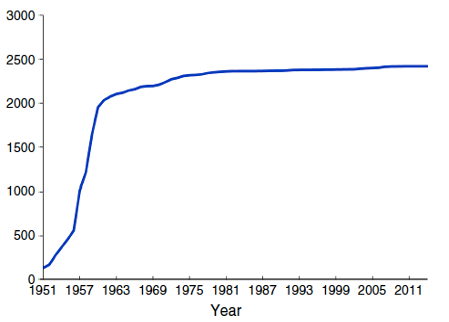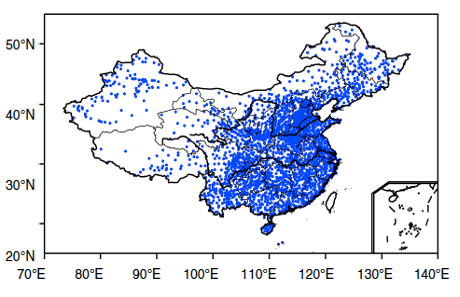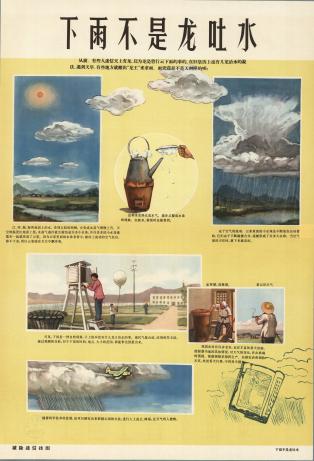This Observations paper reflects upon the changing relationship between local weather, local communities, formal experts, and the party-state in the People’s Republic of China (PRC) and how it is thought of differently today than in the 1950s. Changes as such are not surprising in light of the PRC’s rapid development over the last decades. Past experiences and practices in rural China that are linked to class struggle and mass mobilization are routinely obscured in current public narratives. Yet, how past historical episodes and their legacies are entwined with ongoing developments is often only implicitly addressed in public, if at all. This paper examines these questions as they relate to weather observation and forecasting, with a focus on mass meteorology under Mao Zedong and its later portrayal in official party-state histories during the post-Mao period. It begins by looking at the establishment of modern meteorological stations in the PRC and then examines the coverage in the People’s Daily (referenced as RMRB) of mass-led weather observation and forecasting in the countryside from the 1950s to the 1970s. Finally, the paper looks at official histories of meteorology in the post-Mao period, some years after mass meteorology had been abandoned. In doing so, the paper asks: how were party-state institutions connected to the local level in the early stages of setting up meteorological services, and how did they reflect on this experience in the post-Mao period? These then lead to broader questions about ‘selective silences’ on history and how they might shape responses to contemporary challenges such as climate change in the PRC.
Setting up China’s Meteorological System
Official records of weather observation and prediction reach far into China’s dynastic history. In addition, numerous cultural artifacts and living practices in the PRC are a testament to long-standing knowledge around weather and climate variability, particularly in rural communities, where agricultural livelihoods have always depended on intimate familiarity with local ecologies. Meteorological stations conducting “scheduled observations at designated stations using standardized instruments,” however, were only established in China in the second half of the nineteenth century. Yet, the ambition of establishing a nation-wide observation system and public-facing forecasting remained largely unachieved during the first half of the twentieth century.
In 1949, the Chinese Communist Party (CCP) had only 101 meteorological stations and around 600 technical staff across its vast new nation. The number of stations across mainland China began increasing rapidly in the 1950s (Fig. 1 & 2), and these efforts were supported by many meteorologists who were formally trained in Republican China or abroad.


Figures 1 & 2: Number of stations by year (1951-2014) and location of ca. 2400 national meteorological stations in the PRC. Analysis and visualization by Cao et al. 2016. Note that the current meteorological system further includes other kinds of stations, surface observation posts, radar and satellites.
The CCP aimed for its new meteorological system to aid national development. But how the CCP chose to operationalize this system was strongly influenced by political factors that intersected with the many technical, financial, and staffing challenges of the time. Only a few years into setting up the new meteorological system, the Great Leap Forward (1956-1961) and a turn towards mass campaigns throughout the PRC saw the party-state mandate the mobilization of workers and peasants to speed up socialist development. This redefined political imperatives for China’s meteorological services.
In 1958, the 3rd National Meteorological Work Meeting announced the adoption of mass mobilization for the national meteorological service network (气象服务网). The China Meteorological Administration (CMA) was at the top of this system, which had meteorological offices and stations down to the county-level. Its mission was to establish “a meteorological office in every Mao-era equivalent of a province (专区), a meteorological station in every county, a meteorological post in every township, [and] a Sky Observation Small Group in every commune.” The two lowest tiers, meteorological posts (气象哨) and Sky Observation Small Groups (看天小组), were the mass-led frontline of meteorological service provision. Tu Changwang (涂长望), the first chief of the CMA, described the network as “a meteorological system scattered about the nation like stars in the sky.” (RMRB 28 Dec 1958)
While the organizational structure of this meteorological system aligned with the state administrative hierarchy, local service provision was not supposed to follow a top-down logic. The relationship between stations on the one hand and the mass-led posts and small groups on the other was based on so-called "single station supplemented forecasting experience" (单站补充预报经验). Under this model, said to have originated from local experimentation in Yunnan Province, the two lowest tiers in the system would complement, correct, and even contradict weather forecasts by a county-level station before disseminating them within their communes. This integration of meteorological stations and locally specific meteorological knowledge was supposed to increase forecasting accuracy at smaller scale and better benefit local production. The embrace of local experience in tandem with modern meteorology was celebrated as meteorology “walking on two legs.” (两条腿走路) (RMRB 30 Dec 1959)
The way this meteorological system was envisioned to work was demonstrated in the 1960 movie Tilling Clouds and Sowing Rain (耕云播雨). It tells the story of a woman seeking to bring socialist development to a village through weather forecasting. At first, she neither succeeds in forecasting the weather nor in making farmers trust that modern meteorological instruments could improve their lives. Eventually, she incorporates old farmers’ meteorological knowledge, such as interpreting cloud formations, and starts producing useful forecasts for the village community. This narrative—of successfully mobilizing the masses under party leadership to improve rural life and production through meteorology—is similar to those in People’s Daily articles between 1955 and 1974. Propaganda posters and educational materials aimed at local cadres and educated youth were also used to disseminate meteorological and agricultural knowledge through this new system. For example, one such poster (Rain is no dragon spit, 下雨不是龙吐水, 1965) explained rain as the natural phenomenon of small water droplets formed by air movements and thus independent of any supernatural intervention. Instead of appealing to a “dragon god” (龙王), one could rely on systematic weather observation and old farmers’ experiences.

Figure 3: Woman taking measurements from meteorological instruments housed within a Stevenson screen and a person holding a weather balloon close by (centre left); depiction of an old farmer observing the clouds (centre right). “Rain is no dragon spit” (下雨不是龙吐水), Science Popularization Press, December 1965. Source: BG E37/35, chineseposters.net, Landsberger collection.
Soon after the 3rd National Meteorological Work Meeting in 1958, People’s Daily articles told various accounts of local ingenuity under the new system that also hinted at many problems that went beyond growing pains (e.g., RMRB 28 Dec 1958; 15 Jul 1959). The rapidly expanded number of stations suffered from having little to no experienced staff, whether formally trained or otherwise, and insufficient funding for even basic weather instruments—an issue that even extended into high-level meteorological research. At the same time, voicing concern about the new system was difficult and potentially at one’s own peril. (RMRB 8 Sep 1959; 30 Dec 1959)
By the 1960s, the embrace of the mass mobilization in meteorology appears to have ended. In 1963, for example, all 257 meteorological posts and 30,934 Sky Observation Small Groups in Yunnan Province were dissolved. In the early 1970s, a few final People’s Daily articles reminisced about mass campaigns when praising Mao Zedong, but by 1975 any reference to mass-led organizations in meteorology had entirely disappeared from coverage.
It is difficult to trace when, how, and to what extent local meteorological services were reformed or dismantled since coverage of its mass-led mode in the People’s Daily dwindled dramatically in the 1960s. The formal, non-mass led side of meteorological observations did continue, however, with many local stations claiming a continuous data record since their establishment. The rise and fall of the mass mobilization and its potentially lingering impact on these stations during the rest of the Mao period and beyond remains a fascinating topic worthy of further inquiry.
Looking Back While Moving Forward
After the Cultural Revolution (1966-1976) and the death of Mao, the party-state under the leadership of Deng Xiaoping was eager to turn a page and pursue rapid modernization to catch up with international standards. As part of this, official party-state historiography in the post-Mao period reflected on mass mobilization experiences in meteorology. In doing so, it notes some of the changing relationships between local weather, local community, formal experts, and the party-state. It is noted that during the early, rapid expansion of the meteorological station network, formally staffed stations and local organizations run by lay people worked as part of the same system, and that they were even authorized to correct or contradict forecasts based on their own judgement of local conditions.
The party-state’s clear turn away from endorsing informal knowledge and involving lay people into meteorological service provision is apparent and increasingly pronounced in the post-Mao period. Official histories of meteorology at the national level were published in 1984, 2009, and 2021. In 1984, as part of recent reforms to professionalize the meteorological system, the CMA published a summary of experiences made in meteorology since 1949 (reprinted in Meteorology Soft Sciences 2008). The text criticizes sternly, and in great detail, the rushed expansion of the meteorological system and mass campaigns—especially its antagonistic devaluation of professional expertise and technology. Yet, in a separate section, it also warns that “it is also important to discover, summarize and enhance the masses’ experiences and the potential of already existing technologies in order to prevent pitting mass experience and modern science and technology against each other.”
In 2009, during the Hu-Wen Administration, the CMA published a 60-year history of meteorology. It briefly mentions the introduction of the meteorological service network in 1958, noting that it aimed to provide meteorological services for agricultural production by “relying on the whole party and the whole people (依靠全党全民办气象)," a slogan from late 50s. Otherwise, there are no references to mass mobilization except perhaps for a short reference to “quick development of meteorological education and training.” In general, the text concludes that the early system had followed “correctly guided thinking and a healthy path of institutional development … especially before 1958,” only hinting at the year mass meteorology was introduced. The CMA history also does not engage in any reflection about professional meteorological expertise and technology in relation to local practice, as it did in 1984. The focus is instead on formal institutional development and does not consider activities below the station-level.
A decade later, in 2021, a history of party leadership in meteorology was published for the CCP's centennial celebrations. The history’s timeline begins in 1945 during the CCP’s Yan’an period. Yet its reverence for the communist past does not extend to the mass campaigns in meteorology. The party’s extension of meteorological services to the countryside in 1957 receives only passing mention and the text’s overview of structural reforms to the meteorological system starts with 1980s reforms. The PRC’s history of meteorology is rendered as one of mainly technological progress and obsolescence of earlier stages:
China's weather forecasting has developed from hand-drawn weather maps to independent innovation in numerical weather forecasting, from station forecasting to refined intelligent grid forecasting, from traditional uniform weather forecasting to impact forecasting and risk warning for multiple fields. Climate forecasting has changed from empirical statistics to objective quantification. The accuracy, being ahead of time, precision and smartness of weather forecasting and prediction have been significantly improved.
These official post-Mao histories of the meteorological system have increasingly marginalised and ultimately abandoned references to mass meteorology. Even the cautionary tale about mass mobilisation that appeared in 1984 history is no longer told.
Discarded Pasts and Challenging Futures under a Changing Sky
In the twenty-first century, the PRC no longer lacks weather stations, formally trained experts, or instruments to run a sophisticated meteorological system. And rather than integrating laypeople into meteorology, publishing weather forecasts out of line with authorized weather stations was even made illegal in 2015. In principle, the measures monopolize a professional, institutionalized process to communicate authoritative information about potentially sensitive issues to the public. The current practical function of this legislation should not be overstated, however, since references to its enforcement of fines up to 5,000 RMB appear scarce. So far, the measures have mostly triggered discussion amongst amateur meteorology enthusiasts and commentary by bemused netizens who wonder to themselves whether asking a friend to take an umbrella just in case of rain might attract fines. Yet, similar legislation around natural and other disasters has been enforced when a misleading or unauthorized spread of information was considered sensitive by the party-state, such as “rumours” around earthquakes, chemical leakage, smog, or other environmental emergencies.
Does this mean official histories view mass mobilization merely as a failed attempt to compensate for a lack of technology and that the only useful legacy of the Mao-period system is technology? In reality, non-institutional practices have always informed local understandings of weather and climate variability, preceding and outliving mass mobilization by the party-state into the official system. Farmers continue to gaze into the sky and draw their own conclusions, though now likely accompanied by information available on a smartphone.
Even if the days of meteorological posts and Sky Observation Small Groups refining station forecasts are long gone, the question of how to best relate meteorological knowledge production to local practices remains relevant. Indeed, as climate change dislodges known weather and agricultural patterns, the impacts are inherently felt locally, and any responses by the meteorological services to address new uncertainties will inevitably have to effectively reach local people. Academic research also emphasizes that even today’s technologically sophisticated, professional meteorological system often falls short of addressing local needs, and that improved service provision that takes agricultural management and farmers’ needs into account is required. Modernizing the national meteorological system and improving its service provision remains an ongoing effort, yet past experiments with the PRC’s local weather services and its approach to knowledge production are rarely discussed today. Further research could illuminate whether this is a silent yet understood dismissal of experiences associated with failure and dysfunctionality, at least within the CMA, or whether this selective silence has solidified into a forgotten past that might hold at least potential to reflect about today’s challenges.
This Observations paper does not aim to romanticize mass mobilization of the past or draw a simple line of progress through the complicated decades of PRC history. Instead, a close reading of contemporary sources alongside official historiography contribute to thinking more broadly about “discarded pasts,” that is, experiences dismissed from explicit consideration in discussing current and future approaches to problems. Further consideration of how some silences might nevertheless continue to inform today’s debates could contribute to understanding more about what drives socioecological transformation under climate change in the PRC today. Understanding the role of such discarded pasts in current thinking about climate change could also be important for conversations outside China about the role of indigenous and local knowledge as potential sources for understanding and adapting to climate change.
